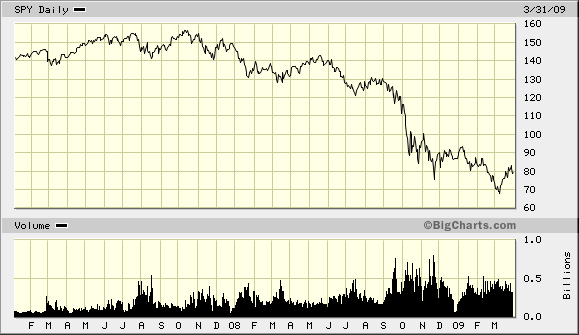
The strategy of buying the dips has worked very well during bull markets. However, every business circle has an upward trend which is followed by a move downward. Technically speaking, a bull market will end when there is a 20% or greater drop from the high point of the major indexes.
On Wednesday, the MSCI All-Country World Index has fallen more than 20 percent from the market peak. So that means that roughly one-fifth of all stock market wealth in the entire world has been wiped out. The selloff in the U.S. markets may seem bad right now but the truth is that they still have a long way to go to catch up with the rest of the world.
Now the S&P 500 had a two-day rally at the end of this week based on a bounce back in the price of crude oil and comments from Mario Draghi that the ECB is preparing a fresh blast of stimulus to halt the slide in global equities. Plus Wall Street believes that the Fed will hold off any interest rate increases until much later in the year.
My trader’s instinct tells me that this is a dead cat bounce in the price of crude oil. I have seen a couple of sucker rallies in oil during 2015 and this looks like a classic short covering rally. Fundamentally, nothing has changed in the oversupply situation and slow world economic growth will not boost demand anytime soon.
So, why is the price of crude oil effecting stock prices?
Wall Street is secretly afraid of another 2008 financial crisis caused by debt that is tied to the price of oil. U.S. hedge funds have been shorting Canadian banks because of their loan exposure to Canadian oil producers. They expect big loan losses will reduce bank profits.
Now, the big U.S. banks are building up their reserves to deal with potential energy-sector losses. In the fourth quarter, Bank of America increased loan loss provisions by $264 million, Citigroup set aside another $250 million while J.P. Morgan Chase added $124 million to brace for potential trouble with energy loans.
Bank of America leads the list with $21.3 billion in energy loans. Citigroup is next at $20.5 billion. Wells Fargo is third at $17 billion. JP Morgan Chase is at $13.8 billion. Morgan Stanley is at $4.8 billion, PNC Bank has $2.6 billion and U.S. Bancorp is at $3.1 billion.
That is only the tip of the iceberg, European & Asian financial institutions also have loan exposure to oil-producing companies in other parts of the world. There are also added risks of debt default from oil-producing countries like Russia, Venezuela, Norway, Brazil and Mexico.

The S&P 500 has begun 2016 with its worst performance ever. This has prompted Wall Street supporters to come out in full force and try to explain why the chaos in global currencies and equities will not be a repeat of 2008. However, these individuals that dominate financial institutions and their economists seldom predict a down-tick on Wall Street, so I don’t expect them to warn of a possible global recession or market mayhem until after the fact.
I believe that no one can time the market so selling everything and holding cash is a very bad strategy. A good strategy would be not putting any new money into this market, raising some cash by selling some poor performing stocks and getting more defensive. I am not a big fan of CNBC’s Mad Money host Jim Cramer but sometimes he goes come out with some outstanding comments.
“Every once in a while, the market does something so stupid it takes your breath away.” – Jim Cramer
The chart below illustrates the daily stock price of the S&P 500 from Jan 4, 2007 until Mar 31, 2009. The market seems fairly flat until Oct 2007 before it started a roller coaster ride downward.

This next chart of the S&P 500 is from Jan 4, 2015 until Jan 23, 2016. Again the market seems flat for a while before the start of a new, more volatile roller coaster ride.

My trader’s instinct tells me that the U.S. markets may bounce up but that the rally will be short-lived because the price of crude oil hasn’t made a bottom yet. I am not a big fan of technical price indicators but the S&P 500 has to break through the 2000 level for this correction to be over and a breakdown below the 1820 level will see more selling. A double bottom pattern that formed during the August 2015 correction is very bullish.
Unfortunately, the average investor closed their eyes, put their portfolio statements in a drawer unopened during the 2008 financial crisis and waited almost 4.5 years to break even. They missed one of the best stock buying opportunities of some really stupid bargains.
“Opportunities come infrequently. When it rains gold, put out the bucket, not the thimble.” – Warren Buffett
What do think? Is it safe to buy now or are you going to sell into the rallies?
For someone who is not a big fan of technical indicators or chart patterns, you do a pretty good job! I like how you combine those with current market and economic conditions. Good post.
LikeLike
Thanks, chart patterns are still a useful tool in recognizing trends. A picture is still worth a thousand words. I just don’t buy or sell because of a bullish wedge or a head & shoulders formation…etc.
I have picked up some great bargains over the years from stocks falling in price because of a computer program that sends out a sell signal based on a bearish chart pattern. I can’t deny that technical indicators do work, but as you know, the percentages aren’t that good.
LikeLike
It is a good point that the basic drivers for the low oil price are still there. Good to be reminded of this.
I am not a technical analyst. I always find the insights that come out of a graph interesting food for thought.
I assume for now that the markets will wait for the Draghi move in March… Maybe we are back into a September – December 2015 period.
I was planning to buy my world index, but it had not yet dropped below my trigger point. I save my cash for the next opportunity
LikeLike
Thanks for your comments, I am not a technical analyst but I do like to use charts to recognize possible trends.
LikeLiked by 1 person
That last paragraph really struck me since that is primarily how I invest. I am a long term investor, but I did just recently sell a poor performing mutual fund (it has been down for years) and currently have that sitting in cash. May have to find myself a good buy while the market is still struggling. I cannot tolerate Jim Cramer long enough to hear what he is saying. Love the quote from Warren Buffet.
LikeLike
I agree with you about Jim Cramer. Hard to believe that CNBC gives him so much air time. I also have some cash on hand to take advantage of some upcoming bargains. I am keeping my eye on the wording of the Fed statement this Wed. and 4th quarter GDP numbers that come out on Friday.
Thanks again for your comments.
LikeLiked by 1 person